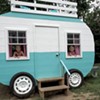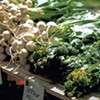Published July 7, 2010 at 8:03 a.m.
My second day as an apprentice at Green Mountain Girls Farm, we castrated little Borealis. It was a three-person job: I held him on my lap, his little spine against my belly, my hands tightly wrapped around his front legs. Laura Olsen, one of the farm owners, knelt at my feet, spreading apart his back legs, while Mari Omland, the other owner, rubbed iodine on his fuzzy goat balls. I could feel his heart racing.
We were up on Omland and Olsen’s back patio, far enough from the pasture where Borealis’ mother and sister were grazing that they might be spared hearing him cry. Omland fished through a box of medical supplies and pulled out a tiny rubber band and a four-pronged stretching instrument for slipping it over Borealis’ testicles. Then she gave him two shots of novocaine, one in each ball. He let out a piercing squeal.
All three of us cooed to him as if he were a baby, and he calmed down before Omland secured the rubber band in place at the top of his scrotum. The balls should shrivel up and drop off in a couple weeks, Omland assured me. He’ll live on pasture with the herd for the rest of the season. And then he’ll probably become a delicious goat burger.
It’s a tough life when you’re born male on a farm.
Olsen and Omland have about 20 goats, 12 of them kids, and they sell their raw milk at their diversified farm in Northfield. I started apprenticing there so I could learn how a real farm works. As a cheese lover, I’ve had a fantasy of raising my own dairy goats. Over the past few weeks, I’ve learned what it takes to turn goat browse into milk, and milk into chèvre. Out there in the field, it’s easy to forget what we’re working for, but one taste of that creamy cheese reminds me: It’s all about the food.
Olsen and Omland hadn’t initially planned on goats. When they made the leap into farming about three years ago, leaving Washington, D.C., where they had worked for more than a decade at conservation and advocacy organizations, they were thinking about raising sheep. But once the snow melted and they got a good look at their land, goats seemed like a better fit.
“There were a lot of shrubby fields, old fields returning to forest,” Omland says. “The fact that browse was a huge component of [a goat’s] healthy diet — we had it. We knew we wanted to keep the land open.”
The goats have proved perfect for that job. They eat everything: trees, grass, shrubs and invasive plants such as bishop’s weed and chervil. During the warmer months, they’re moved to fresh pasture every couple days, not just to find fresher snacking material but so they can avoid eating plants that have been contaminated with their own poop.
When you’re raising goats organically on pasture, a certain level of parasites is unavoidable. But about a month ago, we needed to know just how high their parasite load was. It would help us gauge the general health of the herd, plus, it was about time to start milking again, and an unhealthy goat wouldn’t be able to handle the extra stress. Hence we embarked on a special operation to collect samples for testing. We called it Dung Day.
Even with rubber gloves, the job was pretty dirty. It was my second week as an apprentice, and there I was, kneeling in the field, poking my finger inside a goat’s anus.
How to describe the feeling? It was like reaching into a warm gum-ball machine. The goat squirmed while Olsen held her for me. I apologized for the intrusion and scooped out two little poop balls — gagging just a little — and dropped them into a Ziploc bag labeled “Marlene.”
We were lucky with Boris. The buck sauntered by just as he was letting rip a pouch of fresh pellets. I dashed over to the pile and plopped a few into another bag. Boris is a lovely goat, with a long, black beard and friendly eyes, but he’s quite a bit bigger than the others and has a threatening set of horns, so I was relieved I wouldn’t have to stick my fingers anywhere near his butt.
Results came back the following week: Two does were a bit too parasite heavy. Omland and Olsen had planned to thin the herd anyway, so the duo were sent on a final invasive-species-eating assignment before heading off to become burgers (which were reportedly excellent, topped with homemade salsa verde). But five more goats were ready for milking: Owari, Marlene, Grace, Ingrid and Sophia.
I was surprised how much I liked milking right away, though perhaps I shouldn’t have been. Both Omland and Olsen say some of their favorite moments on the farm have been with the milking team.
“We’re using a product of theirs, but their main goal isn’t to go to slaughter, so it’s easier to establish a relationship with them,” Omland says. “On top of that, the act of milking is so intimate. You’re up against this warm body, and you hear their rumen working. It affects you.”
Sara Armstrong Donegan, who raises goats at Trillium Hill Farm in Hinesburg, agrees, adding that the goats seem to love milking time as well.
“They like getting up on the stand to get grain, sure,” she says. “But I honestly think that they really enjoy the one-on-one time with the person milking them. I have several goats who like to linger and be scratched after they’re done.”
When Omland and I milked for the first time together, we started with Owari, one of the more experienced milkers. She climbed up on her stand, and when she nudged her head through the two bars supporting a bucket of grain, we closed them loosely around her neck so she would stay put. Owari munched away while Omland showed me how to handle the teats. She would later suggest I watch some goat-milking tutorials on YouTube to get my technique down. Which I did — amazed not only by the deftness of some of the milkers but by the incredible range of how-to videos on YouTube.
In movies, it often looks like milking involves pulling down on the teats, but in fact it’s the opposite. Kids head-butt their mothers’ udders before suckling them, stimulating the release of their milk. After gloving up, wiping down the udder and dipping the teats in iodine, I wrapped my fingers around Owari’s teat and squeezed, one finger at a time, from top to bottom. A stream of milk came out! I tried it again with the other hand. Another stream!
Trouble came with Sophia. As soon as we got her head through the bars, she sat back on her haunches, perfectly obscuring her udder and teats, her head bobbing contentedly in the grain bucket. We tried lifting her back onto her feet, but she kept her back legs tucked up under her. We tried raising the grain bucket; she stopped eating but remained awkwardly seated. Finally, Omland lifted Sophia’s back half while I propped a bucket under her belly. It wasn’t graceful, but we were able to get to her teats that way, at least until her squirming made the bucket slip out and we had to start all over again.
Stubborn Sophia was soon booted from the milking team, but the others are going strong.
I came home the other day with a gallon of their milk sloshing around in a massive pot. Omland and Olsen had got me started on a fresh chèvre, which I planned to finish on my own. I had no idea cheese making could be so simple. All you need is milk, culture, an enzyme called rennet, salt, a thermometer and cheesecloth.
On the farm, we heated the milk to 72 degrees (actually, we were distracted and let it heat to 80, so we spent most of our time just cooling it down again). Then we tossed in a quarter teaspoon of mesophilic culture and a tiny drop of rennet. (Both are a little hard to come by; Omland and Olsen order theirs from New England Cheesemaking Supply Company.)
And that was it. When I got home, I let the milk sit, covered, on the counter for about 24 hours, until a clear layer of whey floated on top of the curds, which had taken on the texture of a very soft flan.
Here’s where things got a little messy. I forgot that Olsen had suggested using a colander to support the cheesecloth as I scooped the curds into it, so I tried to cup one hand around the cloth as I scooped with the other. Bad idea. Most of my first attempt ended up on the floor. But the second try went more smoothly. I managed to tie up four balls of curds and hang them from the bottom of a folding card table, a bowl positioned beneath them to catch the dripping whey.
Just 18 hours later, I unwrapped the cloth to find moist and crumbly cheese inside. My gallon of milk had yielded about two and a half cups (plus spillage). I threw it into a bowl and mixed it up with some salt, then folded it into an omelet with sliced tomatoes and basil.
Considering the process, from teat to table, I’ve never worked so hard for an omelet. But it’s never tasted quite so good.
More By This Author
Speaking of...
-

Vorsteveld Farm Held in Contempt Over Runoff
Jan 10, 2024 -

Q&A: Howard Fisher Delivers Meals on Wheels With a Side of Good Cheer
Dec 20, 2023 -

Video: Howard Fisher Delivers Meals on Wheels
Dec 14, 2023 -

Q&A: Alexis Dexter Rescued 57 Shelter Cats During the July Flood
Sep 13, 2023 -

Video: Two Months After the Flood, Alexis Dexter Rebuilds Kitty Korner Café in Barre and Continues to Rescue Cats
Sep 7, 2023 - More »
Comments
Comments are closed.
From 2014-2020, Seven Days allowed readers to comment on all stories posted on our website. While we've appreciated the suggestions and insights, right now Seven Days is prioritizing our core mission — producing high-quality, responsible local journalism — over moderating online debates between readers.
To criticize, correct or praise our reporting, please send us a letter to the editor or send us a tip. We’ll check it out and report the results.
Online comments may return when we have better tech tools for managing them. Thanks for reading.















































